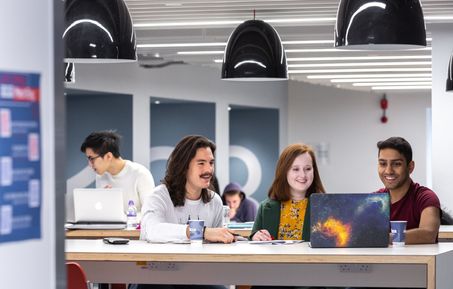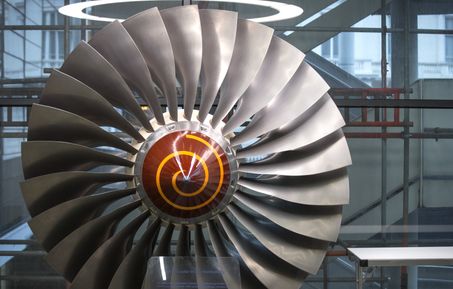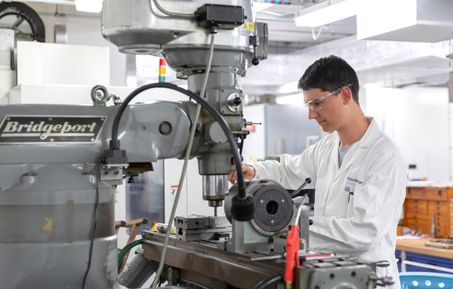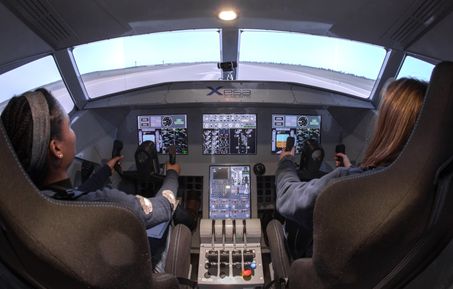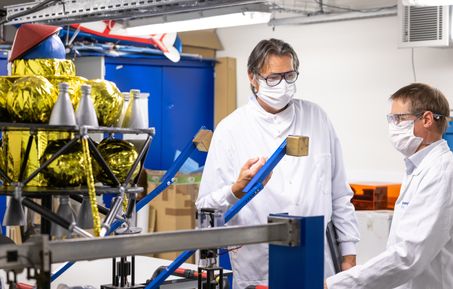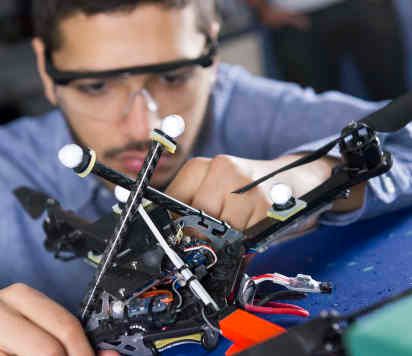Overview THIS NEEDS A PROPER TITLE
- What is Aeronautics?
- Why study Aeronautics?
- Courses Offered
- Available Modules
- Can students do research too?
- Our History - Centenary
Aeronautics is the study of the science of flight"
National Aeronautics and Space Administration (NASA)
The flight of a vehicle through the Earth's atmosphere involves exerting a force, to counter gravity, such that the vehicle appears to magically float unsupported in the sky. Assuming steady level flight of an aircraft, the engines propel the vehicle forward, forcing the air to flow around the wing; the wings, in turn, generate a lift force that opposes gravity. The investigation of all the forces involved in this process is the study of the science of flight.
The terms Aeronautics and Aerospace can be used interchangeably. However, Aeronautics is occasionally used to only specify applications within the Earth's atmosphere. Sometimes, Aerospace is used to encompass both Aeronautics and Astronautics (beyond Earth's atmosphere - space applications). Due to our 100 year history, the slightly antiquated term of Aeronautics is used to encompass applications within and beyond the Earth's atmosphere.

The field of Aeronautics can be further broken down into 5 categories - fluid dynamics; structural dynamics; materials; propulsion; and controls.
A fluid - such as air or water - that moves from one point to another can be obstructed by an object. This results in a force being exerted on the object. Therefore, fluid dynamics involves understanding the forces generated by the interaction of the surrounding fluid and the object. The application of this ranges from the design of aircraft wings to the design of cardiac stents to treat a heart attack.
The forces exerted on an object are borne by its structure. Examples of load-bearing structures are buildings, bridges and skeletons. Consider the can of a carbonated drink, the structure needs to withstand: 1) the outward pressure exerted by gas, 2) the weight of the liquid, and 3) the weight of cans stacked above it. To ensure the can does not fail, the internal forces of structures need to be analysed and a suitable material should be selected. Materials selection requires understanding the requirements of the application. In this example, the material needs to be light, cheap, not interact with the liquid and withstand the structural forces. Material science informs what will be suitable based on the requirements.
The propulsion system of the vehicle dictates the amount of thrust available to move it. For example, the thrust required by a fighter aircraft will be different from a commercial aircraft. Finally, the controls of the vehicle brings together the prior aspects. It ensures the vehicle is able to move in a safe regulated manner from its source to its destination.
Aeronautical Engineering involves studying the interdependence of fluid dynamics, structural dynamics, materials, propulsion and control to design a system capable of fulfilling its purpose.
The breadth of the field is illustrated by the range of research carried out by the Department.
Depth and Breadth
A common misconception is that an Aeronautical Engineering degree is highly specialised and only about aircraft. However, the design of aerospace vehicles is at the intersection of multiple disciplines - fluid dynamics, structural dynamics, materials, propulsion, and controls. Therefore, the fundamentals in each of these fields are first mastered then put into practice. The breadth and depth of the degree are attested by the,
- Accreditation by both:
- Range of research carried out by the Department.
This makes it a highly sought-after course that results in graduates being exceptionally skilled and technically competent.
Research-led, Industry Linked
Imperial College works closely with employers and industry, including Industrial Advisory Panels, to design undergraduate courses which provide graduates with technical knowledge, expertise and transferable skills. The recent curriculum review makes the course is highly relevant to the demands of the industry. Students are also encouraged to take internships and placements. Moreover, with lecturers at the cutting-edge of research, it allows for the best of both worlds.
Teamwork and Communication
As an engineer, one will work in a team to solve problems and complete projects. Our programmes feature a plethora of projects that are interesting and challenging. This allows students to apply theoretical concepts and independently explore beyond the classroom.
These projects are also a platform for one to build up their teamwork and communication skills. During the course of a project, one needs to be able to convey their idea or abstract concepts to another member of a team from which to build upon. Moreover, when there are multiple approaches to solve a given problem, one needs to be able to convince others why one method is better than another and one could go about executing it. At the end of a project, one typically needs to present the idea to an examiner (stakeholders in the real world) or writing a report. For this to be effective, the information must be concise, distilled, and at an appropriate level of detail and complexity for the target audience.
These teamwork and communication skills are highly valued by employers.
Problem-Solving Skills
The challenging nature of the programme allows one to develop problem-solving and analytical skills. There are a few aspects to this,
- How to quickly grasp a new concept and apply it to a new situation.
- How to view the same problem at different levels of abstraction. For example, moving between a detailed and global view.
- How to think from different perspectives, drawing parallels between topics and identifying the interplay/interconnection between different topics.
- How to take a large complex problem and break it down into its component parts. From the component parts, identify the fundamentals that underlie it and what are suitable assumptions. Hence, the simplest possible problem is first dealt with. Complexity can then be gradually incorporated with further iterations such that the complex problem is fully addressed.
Versatile, Adaptable & Transferable Skills
The rigour and multiple transferable skills developed make Imperial Aeronautics graduates highly sought after. Apart from entering the aerospace industry or pursuing further studies, many graduates enter other industries; such as finance, consulting, software engineering.
It is after all only rocket science.
Hear from Benita on why she chose to study Aeronautics:
Benita - Why Study Aeronautics?
What are the options?

All students start on the H401 MEng Aeronautical Engineering course. After the second year, subject to academic performance, there is an option to specialise in Spacecraft Engineering by transferring to the H415 course.
After the third year, a student can remain on the H401 course for the remainder of their degree or transfer to the H410, H411, or H420 courses.
The H410 course involves completing the final year abroad at a partner institution. Alternatively, one could transfer to the H411 course where the fourth year is completed abroad and an additional fifth year is completed at Imperial. A further option is to complete an industrial placement year and transferring to the H420 course.
What's the difference between a 4 and a 5 year degree?
Apart from the difference in curriculum, the ECTS awarded differ. A 4 year degree confers 240 ECTS while a 5 year degree confers 300 ECTS.
The image below provides an overview of the modules available during the course of the H401 MEng Aeronautical Engineering degree. Note that, modules are subject to change each year. 
Yes! Our Undergraduate students have plenty of opportunities to engage in world-class research and use our state-of-the-art facilities to advance the area of Aeronautics. Below are some of the main research opportunities available to our students.
- UROP (Undergraduate Research Opportunities Programme) - This is an additional opportunity available to all students, even first and second year students, to engage in an individually designed research project together with their supervising academic. Projects usually take place over the summer months.
- GDP (Group Design Project) - Each year the whole Department gathers to watch presentations from our GDP students. The range of the projects spans all fields of Aeronautics research. Each group works over 5-6 weeks simulating an Industrial Design Bureau environment. Watch a video recorded by one of our students on what their GDP looked like over the years!
- FYP (Final Year Project) - This is a research project undertaken by all students in their final year of study. The research is carried out on real-world problems and often contributes towards the research group. Many high-quality works result in good journal publications.
Find out more on our page about Student Projects.
In 2019, our Department celebrated a significant milestone - Commemorating 100 years of teaching of Aeronautics at Imperial College London.
The timeline below shows the proud history of the Department, the progress and development, and the significant changes brought about over the past century. You can find the full description of our proud history on our Centenary page.



